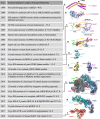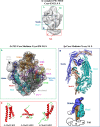Twenty years of Mediator complex structural studies
- PMID: 30733343
- PMCID: PMC6393861
- DOI: 10.1042/BST20180608
Twenty years of Mediator complex structural studies
Abstract
Mediator is a large multiprotein complex conserved in all eukaryotes that plays an essential role in transcriptional regulation. Mediator comprises 25 subunits in yeast and 30 subunits in humans that form three main modules and a separable four-subunit kinase module. For nearly 20 years, because of its size and complexity, Mediator has posed a formidable challenge to structural biologists. The first two-dimensional electron microscopy (EM) projection map of Mediator leading to the canonical view of its division in three topological modules named Head, Middle and Tail, was published in 1999. Within the last few years, optimization of Mediator purification combined with technical and methodological advances in cryo-electron microscopy (cryo-EM) have revealed unprecedented details of Mediator subunit organization, interactions with RNA polymerase II and parts of its core structure at high resolution. To celebrate the twentieth anniversary of the first Mediator EM reconstruction, we look back on the structural studies of Mediator complex from a historical perspective and discuss them in the light of our current understanding of its role in transcriptional regulation.
Keywords: Cryo-EM; Mediator complex; structural biology; transcription.
© 2019 The Author(s).
Conflict of interest statement
The Authors declare that there are no competing interests associated with the manuscript.
Figures



References
Publication types
MeSH terms
Substances
LinkOut - more resources
Full Text Sources
Molecular Biology Databases

